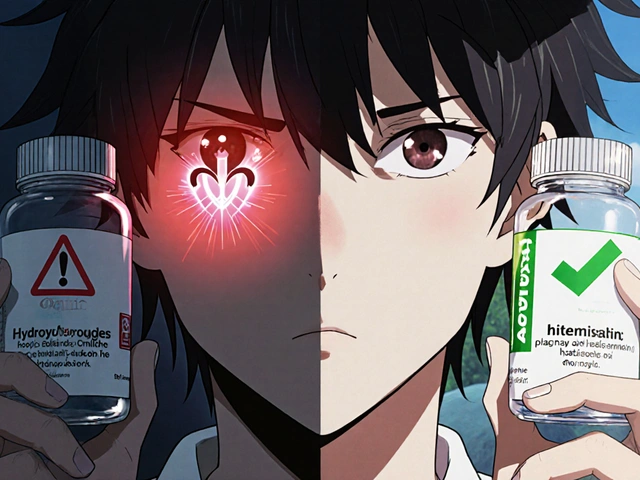Certain names stick in your head when you scroll through a list of anxiety or depression medications, and Effexor is definitely one of those. Whether you’ve heard it whispered about in a support group or your doctor just scribbled it on a prescription pad, Effexor—known by its generic name venlafaxine—tends to stir up both relief and a bit of worry in folks. For some, it sounds like the answer to their darkest days. For others, they're haunted by tales of foggy thoughts or nasty side effects. It's a medication with a personality—complicated and misunderstood, but too important to ignore if the black dog of depression refuses to leave or anxiety won’t quiet down.
What Exactly Is Effexor and How Does It Work?
If you’re hoping for a magic pill that instantly turns bad days into good ones, you might be disappointed—Effexor doesn’t work quite like that. Effexor is classified as a serotonin-norepinephrine reuptake inhibitor (SNRI). Imagine the mind’s mood center as a tangled mess of wires. Venlafaxine helps tidy up by boosting two important neurotransmitters: serotonin and norepinephrine. So, if your brain has been a sluggish traffic jam (think peak hour in Melbourne), Effexor tries to clear a lane or two so the happy and motivating signals can move better.
Doctors first got the green light to prescribe Effexor back in 1993, making it a bit of an old-timer in the world of antidepressants. It’s used for major depressive disorder, generalized anxiety disorder (GAD), panic disorder, and even social anxiety. The fascinating bit? Around 1 in every 20 Aussies aged 16-85 will face clinical depression in any given year, and anxiety disorders are even more common (Australian Bureau of Statistics, 2021). For many, medicines like Effexor are lifelines.
The dosage often starts low—maybe 37.5 mg—then ramps up to between 75 to 225 mg per day, depending on how you respond. Doctors love starting slow because it gives your body (and brain) a chance to adjust. Effexor comes in both immediate-release and extended-release (XR) forms, so you’ll see tabs and capsules with different dosages in pharmacies.
Unlike SSRIs such as Prozac or Lexapro, which stick to serotonin alone, Effexor grabs both serotonin and norepinephrine, making it a bit of a multitasker. That dual approach explains why it sometimes works better for people who don’t respond to plain ol’ SSRIs. There’s also data showing Effexor may kick in just a bit faster for certain folks, with some relief showing up in two weeks—even if the full effect takes a month or more. Still, like every antidepressant, the brain takes its sweet time to readjust. If you’re on it, patience is more than just a virtue—it’s required.
One underrated fact? Effexor is sometimes prescribed off-label for things like hot flashes during menopause, nerve pain, and even chronic migraines. But for anxiety and depression, the science is strongest—which is why those are the billboard uses.
Benefits Real People Notice with Effexor
So, what happens when Effexor starts working? It’s rarely dramatic—a sudden burst of happiness isn’t the norm. Instead, most people describe a gentle lifting of the weight on their chest. Social situations don’t feel quite so terrifying, and those stubborn negative thoughts lose their bite. For people like my mate Jack, who went through a nasty patch of panic attacks, it meant less dreading everyday stuff—commuting, talking to strangers, even replying to emails.
According to a 2023 study published in the Medical Journal of Australia, about 56% of patients saw significant improvement in moderate-to-severe depression symptoms after twelve weeks on venlafaxine. The benefits extended beyond just mood. Many people reported sleeping better, improved focus at work or school, and less physical tension—like tight chest muscles and jaw clenching melting away. If you’re an anxious overthinker like me, that’s no small thing.
Another unexpected win? For those who grapple with social anxiety, Effexor sometimes acts like a volume dial, turning unwanted self-consciousness down just enough to get through a meeting or the dreaded school pickup line (been there). Instead of counting ceiling tiles and sweating through your shirt, you just... exist. And that’s a huge step up for people who usually spend all their energy dodging human interaction.
Here’s a tidy visual of what users have noticed, based on survey data from both Australian and US patients:
| Improvement Area | % Of Users Noticing Benefit (12 Weeks) |
|---|---|
| Depressed Mood | 56% |
| Anxiety Symptoms | 61% |
| Better Sleep | 47% |
| Improved Concentration | 38% |
| Less Social Avoidance | 29% |
The numbers don’t lie—more than half feel a real difference. But it’s not a home run for everyone. There are always people who don’t see much change or only feel better with therapy, exercise, and support alongside the meds. But when Effexor works, it can be the push that gets you up and out again—even if it’s just to take the dog for a walk or drop your kid at school without feeling overwhelmed.

Side Effects and Risks Most People Miss
Okay, let’s get real: Effexor has a bit of a scary reputation on Reddit forums and in Facebook groups, and there’s a reason for that. The most common side effects pop up fast—nausea (nearly half of new users), weird sweating, dry mouth, dizziness, and trouble sleeping. Some people feel jittery for the first week or so, which can be weird when you’re already anxious. But these usually fade within a month. Doctors might suggest starting with an evening dose to sleep through the worst of it, which helps some folks but not others.
For me, dry mouth was like suddenly living inside a sandpit. Plain water barely helped, so I kept sugar-free gum in every pocket. Amelia joked I looked like a kangaroo with a constant jaw massage. Not dangerous, but annoying.
Then there’s the notorious withdrawal—venlafaxine is famous (infamous?) for causing brain zaps and feeling flu-ish if you skip a dose or quit too quickly. It’s not a matter of willpower; your brain literally gets scrambled. Experts always recommend tapering down the dose super slowly under medical guidance. Quick tip: set alarms if you’re forgetful because missing even a single dose can send you spinning. It’s not a class of street drug, but your body sure treats it like one when you stop suddenly.
Other side effects worth keeping in mind: some people feel more anxious before they feel less anxious, and a few experience high blood pressure—so you might have a few extra doctor check-ins than you expected. Sexual side effects are also common. Libido might shrink, and orgasms may take a detour (or not arrive at all), which nobody really tells you in the pharmacy aisle.
Rarely, but seriously, some users experience manic symptoms (especially if you have undiagnosed bipolar disorder), severe increases in blood pressure, or even serotonin syndrome—especially if you mix Effexor with other meds that increase serotonin (like St John’s Wort or certain painkillers). That’s why you need to squeak honestly about everything you’re taking, even those “natural” tablets clogging your bathroom shelf.
- Strictly never double up doses if you forget—ask your doctor what to do
- Keep track of your blood pressure the first few months
- If you start feeling weirdly hyper, shifty or get crazy sweats, call your doctor ASAP
- Talk to your doctor about any pre-existing heart or liver conditions
Kids and teens on Effexor are rare, but it’s sometimes prescribed with extra caution. There’s also a slightly higher risk of suicidal thoughts, especially in the first month for young people. That’s why you should never leave teenagers or younger adults to just cope alone after starting—they need proper check-ins.
Tips, Tricks, and Life Changes While Taking Effexor
If Effexor is your daily companion, life changes around it. Pill boxes become part of your morning routine—right next to the car keys. You quickly discover which foods make nausea worse and which make you feel steady. For me, eating a small meal before the capsule made all the difference, but skipping coffee for the first hour was key. Everyone’s body reacts differently, so you sort of become your own guinea pig—figuring out what keeps headaches and queasiness at bay.
Here are some trial-and-error tips from folks in Melbourne support groups (and my own kitchen table):
- Take Effexor at the same time every day—early consistency beats late drama.
- If you miss a dose, don’t panic. Just take it as soon as you remember—unless it’s nearly time for your next one, then skip. Never double up.
- Invest in a water bottle you like for constant sipping—dry mouth is no joke.
- Don’t judge the med until you’ve been on it for a full month—side effects usually fade after week three or four.
- If you’re feeling uncomfortable, don’t be silent. Telling your doctor early can save a lot of regret and hassle.
- Keeps snacks handy. Bland stuff like crackers can settle your stomach if the nausea is bad.
- Warn your family—Amelia and Oliver learned to spot my mood shifts and helped remind me to hydrate and rest.
- Consider tracking how you feel in a journal—helps you see patterns and talk to your doctor more clearly.
- Set blood pressure checks on your phone—some pharmacists in Melbourne will let you use their machines for free.
- Avoid alcohol or recreational drugs if you can. They can mess with how effexor works and complicate withdrawal.
It’s pretty normal to still have low days or anxious spells, even once the medication kicks in. Therapy, exercise (even if it’s just a stroll by the Yarra River), and strong support from friends or family are key parts of getting better. Think of Effexor as one tool in a bigger toolkit. You wouldn’t try to build a house with just a hammer, right?
What really stands out about Effexor is how personal the experience becomes. Some folks can’t imagine their day without it. Others ride out the rocky first month and decide it’s not for them. There’s no shame in either. As with any mental health medication, honesty—with your doctor and yourself—is the best way forward.





Comments (14)